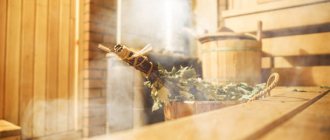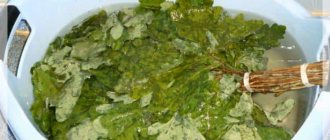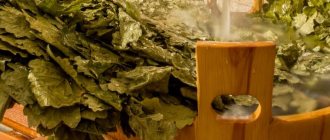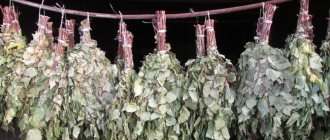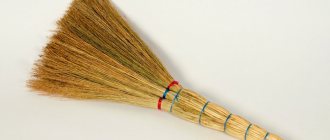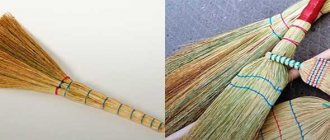In the vast majority of cases, the rightful and absolutely deserved place in the bath pantry is occupied by two main types of brooms: birch and oak. However, traditional bath culture knows a lot of examples of the use of brooms from other, not quite familiar, plants in steam rooms: from nettle to juniper. And what place do spruce brooms occupy in this hierarchy? Let's get a look.
Properties
High rigidity
This is the main thing for which a spruce broom is valued. Not everyone enjoys steaming with needles. This requires minimal “thick skin.” But when harsh impact is necessary, a spruce broom is indispensable.
Presence of phytoncides in the composition
This is the healing aspect of the spruce broom. Chronic colds of the respiratory tract are also “knocked out” with such a broom. Intensive massage combined with pine vapors make a good contribution to the treatment of colds.
Sufficient flexibility of rods
The high rigidity of the spruce broom due to the needles is combined with the flexibility of the branches. This allows you to have a strong impact on the skin without damaging the tissue. Properly processed branches bend well when impacted. This property is important in the treatment of radiculitis, for example.
Non-toxic
The pores are steamed when visiting the bathhouse, and the broom is also steamed and releases its plant substances onto the skin. They are partially absorbed internally, providing a beneficial cosmetic effect. And they do not cause harm, like many synthetic products.
Beneficial effects of pine needles
The buds of spruce needles contain many plant pigments and carbohydrates. Vitamin E and ascorbic acid are also present. In other words, spruce contains beneficial elements necessary for improving health.
Needles actively influence the human body. Let's highlight the main actions:
- Antiseptic.
- Mucolytic.
- Anti-cellulite.
- Painkillers.
- Regenerating.
Thanks to phytoncides, the air is purified. The aroma of spruce helps cleanse the body, improve mood and add strength.
At the beginning of the procedure, you will have to get used to the idea that you will need to prepare for acute sensations. Bath broom needles cause constant discomfort. However, with each subsequent blow, the surface of the skin is cleansed, and deep breathing allows the lungs to heal.
How to steam?
In the classical way, it is customary to soak a spruce broom in boiling water for at least half an hour before using it. If necessary, longer, until the needles acquire the desired condition.
If, on the contrary, a strong massage is needed, steam the pine needles lightly or do not put them in boiling water at all. Hard, slightly steamed brooms are used mainly for cosmetic procedures. You can use completely dry ones, but only fresh ones. Dried spruce quickly crumbles. And a dry broom is more dangerous.
Important! At the same time, the person must be prepared: the body must be steamed so that the skin becomes more elastic and accustomed to the high temperature.
And here’s what a bathhouse lover, Valery Fedorov, says: “We have a spruce forest growing nearby. There is also birch, but in the bathhouse we like spruce brooms because of their roughness. Steam the spruce broom in hot water for at least two hours. The bathhouse is filled with pine steam.
Good disinfection, by the way. In the meantime, we steam the person with a birch broom, pour a mixture of well water and snow on him.
After such a thermal shock, we use a softened spruce broom. After icy water, the spines are almost not felt. And those who are used to it can do it without preparation.”
Spruce in folk mythology
In fairness, it should be said right away that in the legends and myths of many peoples of the world, the spruce tree is associated with the cult of the dead. In our Slavic tradition, in some places, a spruce broom for a bath was not used at all, at least in everyday life. Its purpose was determined by its function alone. They used it to steam the dead, arranging the last washing in this world for those leaving for another world. Such currents were especially strong in the Russian North and among the Old Believers.
Even folk wisdom has preserved for us some examples identifying spruce as a symbol of death. The expression “Looking under the Christmas tree” meant being sick for a long time, being on the verge of life and death. And the phrase “Walk along the spruce path” actually pointed to the right path towards the best of worlds. Indeed, even in central Russia, the deceased was covered with spruce paws, the floors in the rooms and the path of the funeral procession were covered with them, and the grave itself, in the order of things, was covered with spruce branches during winter storms.
In ancient Roman culture, even Pliny the Elder, at the dawn of the birth of Christianity, pointed to spruce as the “tree of the dead.” The ancient Germans considered the tall, powerful spruce that supports the sky as a kind of analogue of the World Tree, in the crown of which the confrontation between Good and Evil takes place. The spruce forest is always gloomy, silent and gloomy. Owls and eagle owls love to settle in the dark crown of this tree, which from ancient times were considered the first assistants of the devil. Due to the fact that spruce is often struck by lightning, our ancestors believed that evil spirits found refuge there.
Until now, in Belarus there are strong beliefs about the inadmissibility of planting spruce near the house. In Polesie, in clean spruce forests it was not customary to collect mushrooms, berries, medicinal herbs and roots. It was necessary that in the groves the spruce should coexist with other tree species that would dilute its negative energy. Well, at the end of this section, it’s worth saying that spruce was especially unkind to men. It got to the point that superstitious representatives of the stronger half of humanity categorically refused to harvest spruce wood, either for firewood or commercial timber.
When to harvest?
The spruce is covered with a green crown all year round.
But for bath brooms it is customary to cut off the branches in certain months:
- December;
- January;
- February;
- March;
- May;
- June.
This is due to the content of valuable substances and the growth rhythms of spruce. In the winter months, the needles have a high content of vitamins: C, B2, and from March the active growth of young shoots begins. These young shoots are the best raw materials for making brooms. It is better to cut them from the north-west or south side. The most suitable branches are from the middle part of the tree.
Expert opinion
Lovkachev Boris Petrovich
Bath master who knows everything about steaming
Important! Even the place where the spruce grows matters. Needles grown at higher elevations will be of higher quality. A tree from lowlands quickly sheds its needles when it dries out and cannot be stored.
Fir
Fir brooms are best used for bathing procedures in winter. The oil contained in fir is useful for various diseases. Infusions are even made from fir, which have long been used in Siberia as a means of combating fatigue, various colds, scurvy, aching bones, and gout. Also, fir broom is a natural relaxant, helping not only to relieve internal tension, but also helps calm the entire nervous system. Therefore, traditional healers recommend drinking this infusion before bed. Then your sleep will be pleasant and calm.
During bath procedures, a fir broom is also effective, helping to cure colds and inflammatory diseases. Also, in combination with a fir broom, fir oil, tannins and phytoncides are used, which penetrate the pores of the body, curing skin diseases and rheumatism. After all bath procedures using this broom, pathogenic bacteria leave the body, helping to cleanse and smooth it.
Fresh broom
Fresh, green spruce brooms are used for steaming in the sauna.
It is not advisable to use dry ones, as they crumble.
Because of this, it is not possible to harvest a large number of spruce brooms for future use.
Healthy! It is still possible to stock up on a few brooms in those regions where there is snow. If you place spruce brooms in loose snow without an ice crust, they will be stored. This can be done not only with new ones. After use, if you leave the broom in a snowdrift, its properties will be preserved. It is possible to steam it repeatedly – up to three times.
What raw materials are suitable for a bath broom?
The ideal time to collect the raw materials from which the broom will be woven is mid-July. At this time, the leaves become soft and exude a stunning aroma. It is generally accepted that you need to prepare branches for Trinity. As you know, this church holiday is celebrated at different times every year. Basically, it occurs at the end of May - beginning of June.
According to popular beliefs, the process of weaving brooms must be completed after August 2 (Ilyin’s Day). The exception is brooms made from oak branches. It is believed that by this time they are not able to show their healing effect.
Harvesting brooms should be done on a warm, dry day. Never collect raw materials in the following places:
- in areas where power lines pass.
- near factories and factories;
- near highways.
When you cut the branches, check that they are well attached to the post; it is unacceptable that they fall off due to slight shaking. Give preference to specimens that are devoid of thorns and those that do not have resin.
Show respect for trees! Trim as few branches as possible. For brooms, specimens from young trees that have not reached 3 years of age are suitable. They bend well and are endowed with healing powers. Don't bother yourself and climb to the very top of the tree to collect raw materials. The most suitable specimens grow at the bottom of the tree.
If you want to make a broom from birch branches, take a closer look at the trees that grow near the water. They are often called “weeping ones.” It is worth noting that you can find out how good a broom will be even before using it. If the leaves have roughness, discard such branches. Give preference to leaves with a smooth surface. Cut the shoots from the sides. For this, use gardening tools in the form of secateurs.
Do not put cut shoots in bags, because they will lose their elasticity in them. As for transportation, for this they can be bandaged or transferred to the car. Do not tie the branches tightly, as they will have to dry out.
Proper vaping
When using a spruce broom, the most important thing is not to damage the skin.
To do this, four points must be observed:
- First prepare the broom correctly - steam the needles until they become softer.
- It is good to steam the skin so that it becomes more elastic and not susceptible to damage.
- Warm the body with a broom using movements along the body to prepare for exposure to high temperatures.
- Start soaring with light effects, gradually moving to more intense ones, depending on the person’s condition.
Indications and contraindications
Thanks to a spruce broom, you can be confident in the effectiveness of various procedures that help improve your health. The use of spruce is an excellent alternative to modern procedures and massages. After the bath, the respiratory tract is cleansed, the activity of the cardiovascular system improves, and the calm of the nervous system is restored. Also, when the first symptoms of a cold appear, a bath will help.
Indications for procedures:
- The appearance of inflammatory foci in the respiratory tract.
- Cystitis.
- Radiculitis.
- Asthma, severe cough.
- Cold.
- Pain in muscles and joints.
- Kidney problems.
When undergoing bath procedures, it is important to consider that pine needles are non-toxic.
During the process of steaming the body, a rapid release of sweat occurs through the skin. Toxins are also actively removed. And additional massage helps speed up this process and get rid of depression.
Contraindications to bath procedures:
- Presence of ulcers on the body.
- Great sensitivity to turpentine.
- Hereditary predisposition to allergies.
When is it useful to use a spruce broom in a bathhouse, and when is it harmful?
Spruce also has medicinal properties. Although, of course, it cannot be classified as a medicine, in some cases it will have a beneficial effect, in others it will be harmful.
| Useful if: | Not possible if: |
| Residual effects of colds | Allergic reactions |
| Radiculitis | Poor tolerance to turpentine |
| Orange peel effect on the skin | Ulcerative skin lesions, burns |
Bath lovers sometimes have questions about the use of spruce brooms. Not everyone is used to steaming with a Christmas tree. The latter, received by mail, are answered by Stepan Trukhin, a bathhouse attendant with seven years of experience.
Once I used a spruce tree, there were only bare branches left. I use oak several times. What kind of violation may occur during manufacturing?
Most likely, they dried it more than necessary. But in principle, spruce ones are not designed for long-term use.
I bought a spruce broom, started to hover, and after 10 minutes it fell apart. It was held together with some natural material. How to choose a broom in future?
Spruce brooms are often held together with willow bark. This is normal, but it must be fresh. If it's dry, don't take it, it will fall apart.
I want to make a spruce broom myself. What is the best way to fasten it?
Take linen thread. When the broom cools, it shrinks and the broom does not fall apart.
Can soaring with a spruce broom leave scars on the skin?
They can, if you steam the broom poorly, on the skin. Always evaluate individual feelings. Reduce the load if necessary.
I have a bad cough. Can I use a spruce broom?
Find out the cause of the cough and consult your doctor. If you have allergies, it is better to abstain.
A spruce broom can be a good tool for massage in the hands of a competent specialist. Perhaps there are those who want to use it constantly because of the unique sensations that are different from brooms with leaves.
It is important not to forget that it consists of needles and to take into account the individual sensitivity of the skin. Its short shelf life makes it an infrequent “guest” in baths. But a fresh broom is much more fragrant.
The benefits of spruce procedures from a scientific point of view
If you do not consider yourself a supporter of prejudices and look at all processes from a purely scientific point of view, then this section is exclusively for you.
Spruce is a storehouse of vitamins, microelements and biologically active substances, which, first of all, include phytoncides.
It is no secret that this tree belongs to the group of long-lived trees and, as radiocarbon analysis has shown, on the rocks of Western Sweden there is a specimen that is about 10,000 years old. Obviously, the trunk is a shoot - a clone, however, the root system appeared long before the Nativity of Christ.
The evergreen crown of this plant - the needles - has a number of outstanding properties, among which the following are especially worth noting:
- Antimicrobial, which is expressed in the ability to suppress the development and activity of various pathogenic microorganisms;
- Anti-inflammatory, similar to the first, and based on a high concentration of phytoncides;
- Painkiller. Naturally, in terms of effectiveness it cannot compete with synthetic analgesics, however, for a purely natural remedy, the level of impact on the receptors of the human body is quite noticeable;
- The high content of vitamins, primarily ascorbic acid, causes an active antiscorbutic effect. It is not without reason that in Siberian logging sites, experienced prisoners preferred tea, a decoction of spruce needles mixed with a certain amount of young bark. Despite the very mediocre and peculiar taste of the drink, the pine needles provided the body with a shock dose of vitamin C, and the bark, which has a pronounced astringent property, blocked bleeding;
- It is worth noting the high diuretic, choleretic and expectorant qualities of such raw materials.
Attention! Spruce needles are a good source of essential amino acids and microelements, represented by salts of zinc, iron, cobalt, selenium, copper and manganese. A real green laboratory!
In order to fully reveal the positive potential of spruce needles, we present the following table:
| Name of vitamin or microelement | Concentration, expressed as mg/kg of dry needles |
| Carotene | 140 — 320 |
| Vitamin E | 340 — 355 |
| Vitamin C | 250 — 300 |
| Vitamin P | 900 - 2300, in some climatic conditions the content can increase to 3800 |
| Vitamin PP | 29 — 142 |
| Vitamin K | 12 — 20 |
| Vitamin H | 0,06 — 0,12 |
| Vitamin B1 | 8 — 19 |
| Vitamin B2 | 5 — 7 |
| Vitamin B3 | 16 — 28 |
| Vitamin B6 | 1,1 — 2 |
Features of harvesting spruce brooms
Applied botany has proven that the concentration of useful substances contained in spruce needles varies, and within fairly significant limits, depending on the time of year. The maximum amount of vitamin C and vitamin B2 occurs from December to February, and for all others, from May to June.
Important! Subject to certain storage conditions for harvested raw materials, namely a temperature of about 2 - 5 degrees Celsius and the absence of direct and diffuse sunlight, it is possible to preserve useful substances in the needles by almost 85 - 90% during the current calendar year.
The highest quality are young shoots growing in the middle part of the crown, located in its southern and southwestern parts. The tips of the shoots are most saturated with active elements, which differ from the main mass in being lighter in color and delicate, soft texture.
It is also worth remembering that trees growing on dry hills provide more valuable raw materials than their relatives from shaded areas, swampy and wet lowlands.
When forming a broom, it is imperative to correctly and correctly form its handle. The branches are cleared of bark, laid tightly to form a circle or ellipse, and tied tightly with a cloth strip or PVC tape. The number of layers of strapping should be such as to guarantee both the strength and integrity of the connection and the absence of resinous discharge.
Rules for using spruce brooms in the bathhouse
In order to get a positive effect from the use of coniferous brooms, in particular spruce ones, you must adhere to fairly simple but very significant rules:
- Brooms made from spruce shoots should not be used by people with delicate and sensitive skin.
- Brooms should be stored in a dark and cool room with low humidity, not subject to sudden temperature fluctuations. The optimal temperature for long-term storage should be a temperature not exceeding 7 degrees Celsius, with a relative humidity of about 45%.
- Before use, if such a broom was stored in a barn or unheated room, it must be kept in a warm dressing room for 35 - 40 minutes.
- After temperature adaptation, which helps keep the needles from shedding during use, the broom is steamed in a tub of water at a temperature of 75 - 85 degrees Celsius. The rule for choosing temperature is simple. The longer the broom is stored, the higher the water temperature. During the steaming process, which lasts about 30 minutes, the broom is periodically turned in the container, briefly removed from it and shaken off with careful, delicate movements. It is very advisable to maintain the water temperature at the same level from the beginning to the end of the process by adding boiling water to the tub, but not on the broom itself, but closer to the wall of the container.
- After steaming, the broom is tightly wrapped in thick natural fabric to “ripen” for another 5 - 7 minutes. During this period, a correctly and competently prepared instrument acquires its final consumer standards.
- In the steam room, the steamer first takes the steam cake from the ceiling of the room with a broom onto the body of the steamer, and then gradually begins to massage it with light springy movements. It is customary to use a spruce broom to apply short, targeted blows without drawing them across the body. The rhythm should be small but frequent, with uniform movement from the ankles to the middle of the neck and in the reverse order. When treating radiculitis, a small cross-shaped traction with a broom along and across the lumbar spine is allowed.
- For those who, due to sensitive skin, cannot join in the sacrament of soaring with a spruce broom, a more gentle option can be offered as a good alternative. Spruce paws either locally or completely cover the floor of the steam room, and the patient actively tramples on the needles, performing a kind of acupuncture massage of the feet, on which a large number of active reflex zones are concentrated.
- Reuse of a spruce broom, as a rule, does not occur, primarily due to the subsequent abundant shedding of needles from the branches after working in the steam room.
A word from Experienced! In traditional Old Believer settlements, it was practiced to make a kind of barometer, which, with relative, in modern perception, reliability, could predict weather changes in the short term. To do this, from a spruce broom that had been stored for at least six months, a completely dry, even branch of about 250 mm was broken out from its lower part. In the original, the length is no less than the distance from the tip of the thumb to the tip of the middle finger of the outstretched palm of an adult man - the head of the family. The twig is carefully cleared of bark and a natural coarse thread is tied to its ends with a slight tension. The manufactured device is suspended above the front door on the street. If the thread loosens and loses tension, it means that in the near future we should expect a sharp change in the weather towards its deterioration. If the tension was restored, then the weather should also be restored to its calm flow.

